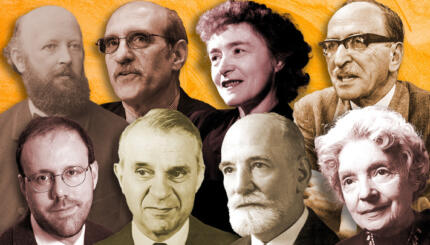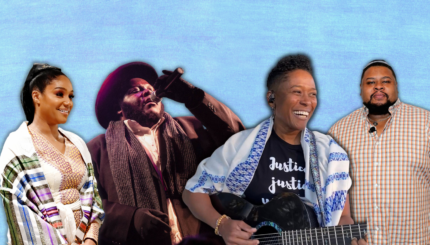Adoption is on the rise in the Jewish community. And with this trend increasing numbers of children from a variety of racial backgrounds are becoming part of the Jewish community. This article, reprinted with permission from Beliefnet.com, explores this growing trend.
Ari Wolff’s mom was worried about sending her 8-year-old to overnight camp for the first time last summer. She had the usual concerns: Would he be homesick? At a Reform Jewish camp in California, would he be too far from their home in Honolulu?
But she also had one more: Would children tell him he wasn’t Jewish because he is black?
Trans-racial Adoptions


Help us keep Jewish knowledge accessible to millions of people around the world.
Your donation to My Jewish Learning fuels endless journeys of Jewish discovery. With your help, My Jewish Learning can continue to provide nonstop opportunities for learning, connection and growth.
Ari, now 9, is one of a growing number of children from African-American, Latino, Asian, and mixed-race backgrounds being adopted by Jewish parents. Nearly unheard of 15 years ago, trans-racial adoptions are today, quite literally, changing the face of the Jewish community.
No one knows just how many Jewish children come from other ethnic backgrounds.
In years past, most were born in Korea, Vietnam, and Latin America. Americans–of all religions and ethnicities–continue to adopt children from those countries, but today, experts say, the former Soviet Union and China are the leading birth countries in international adoptions and are the source of 4,500 and 4,000 children, respectively.
And while domestic adoptions of children from black and Hispanic backgrounds were first seen in significant numbers in the early 1970s, they seem to be increasingly popular among Jewish parents today.
The 1990 National Jewish Population Study–the last completed “census” of American Jewry–found that 6.5 percent of all respondents were nonwhite, said Gary Tobin, president of the Institute for Jewish and Community Research, based in San Francisco.
Four percent of the study’s “core population”–meaning Jews by birth or conversion–were black or Hispanic, he said, which equaled about 220,000 people.
A decade after the study, it’s now possible that through adoption, adult conversion, and intermarriage, the percentage of nonwhite Jews in America is as high as 10 percent, Tobin said.
One adoption professional estimated that between 15 percent and 20 percent of the children currently being adopted into Jewish families are Hispanic or nonwhite.
“These children are gradually changing the face and color of what people think is Jewish life,” Tobin said.
Diversity in the Jewish Community
The personal experience of Tobin and his wife, Diane Tobin, led them to start the Ethnic and Racial Diversity Study of the Jewish Community, which got underway a year ago and is now concluding the first phase of research, interviews, and questionnaires surveying 500 families.
All the respondents were hungry for ongoing contact “with people like themselves,” said Diane Tobin, who is directing the study. In response, the project has also turned into a network, with periodic meetings and speakers.
The Tobins were married a few years ago when they were in their mid-40s and have, between them, five children from previous marriages. They soon realized they weren’t likely to conceive, given Diane’s age. Six months after they decided to adopt, Jonah, who is now a toddler and is African-American, arrived.
“People have been very supportive” of their decision, Gary Tobin said, though “both white people and black people are curious about why somebody would want to do this.”
Issues of race become part of Jews’ everyday lives when they adopt children of color.
There’s a good chance that Jonah will be treated differently than white children will, said Tobin. “He will be a minority within a minority wherever he goes, as a black being raised in a white family, as a black within the Jewish community.”
Tobin isn’t alone in being concerned about his child’s experience as a black child in a white family. The National Association of Black Social Workers has, for the past two decades, promoted the view that black children should be placed with black parents.
“The non-African-Americans mean well but have not had the intimate experience of being raised in a discriminatory and racist society, as we have, and cannot pass along the values we need to our young people, as well as the inheritance of our African ancestry,” said Rudolph Smith, national president of the organization, in an interview.
Despite the concerns, an increasing number of such children are being adopted by white Jewish families–enough that a new organization, the Multi-Racial Jewish Family Network, is now being created to deal with some of those issues.
“We hope to bring people out of their isolation” as Jews of color, said Jean Weinberg, a Boston-based management consultant. The network is addressing the needs of Jewish families with nonwhite members through conversion, intermarriage, and birth, as well as through adoption.
Multi-racial Jewish families
While there are a few places–including Boston, New York City, and parts of California–where Jews of color find comfortably diverse synagogues and other Jewish environments, many people live where they are one of only two or three multiracial families, Weinberg said.
“We need a network so our children can have a reference group in which they can ground themselves,” said Weinberg, the mother of two adult biological children and the adoptive mother of 5-year-old Sarah Julia, whose birth mother was Swedish and birth father was black.
As emotionally and spiritually complex as adoption is for anyone, it is all the more so for those who adopt from different ethnic backgrounds.
“Adopting interracially is like donning a permanent sandwich board that advertises your adoption (and your infertility too),” wrote Jana Wolff, Ari’s mother, in her book Secret Thoughts of an Adoptive Mother.
In an interview, she said, “We’ve increased the ways in which Ari stands out. He’s different by being adopted, by being Jewish, by living in Hawaii, by having a Hebrew name. And it’s very hard to think you’ve contributed to making things difficult for your child.”
For those reasons, some consciously decide against adopting cross-racially. Rabbi Simkha Weintraub and his wife, Simha Rosenberg, had already adopted Adin, who is white, when they investigated adopting a second child.
They were offered a nonwhite baby, who they turned down. “It was a wrenching experience for us,” said Weintraub. But “we didn’t want to put Adin in the position of having to answer questions about his sister or brother every time they went to the playground,” said Weintraub, who works as rabbinic director of the National Center for Jewish Healing, which is based in New York. “We didn’t want to impose a neon sign on them.
Since then, they have welcomed Meirav, who is Caucasian and now 5, into their family.
Heightened racial consciousness is part of adopting across racial lines, and Jewish families often find themselves suddenly in the position of having to raise awareness about color-sensitivity issues within the larger Jewish community.
They also work hard to bring their child’s ethnic background into their lives. For some, that means using the Passover to focus on the struggle of African-Americans and other ethnic groups.
For the Wolff family, it has meant seeking out relationships with African-American men in particular and making an effort to find “models of color” for Ari.
It has also meant creating “Kwaanzukkah,” a blend of and the African-American holiday Kwanzaa, which they celebrate together with friends.
In the end, Ari had a fine time at summer camp last year. The race issue didn’t come up at all, as far as his mother knows, though as she sewed name tags into his underpants before he left, they role-played possible responses to people’s questions.
Ari had such a good time that this year, he’s going back.



